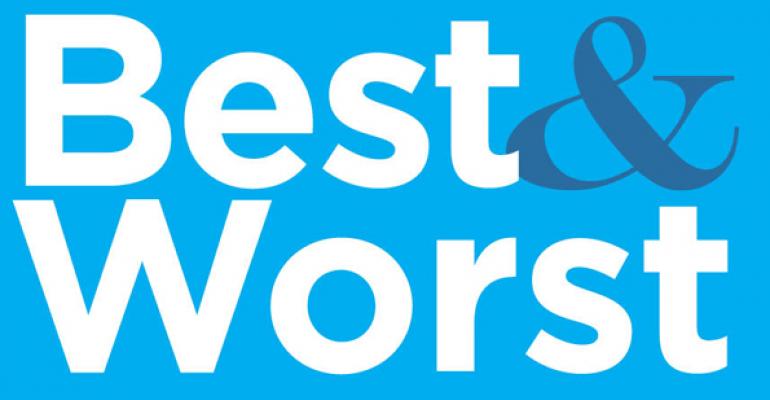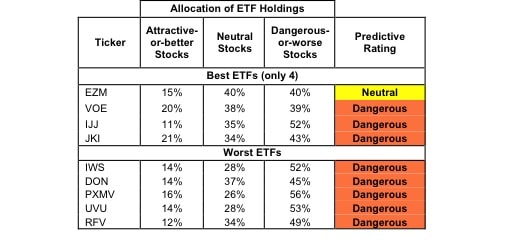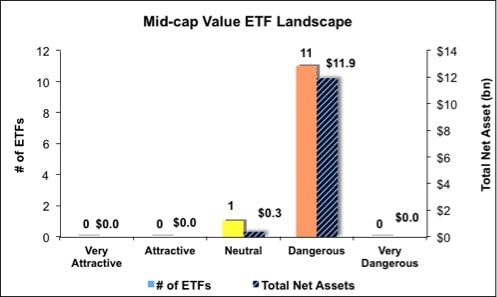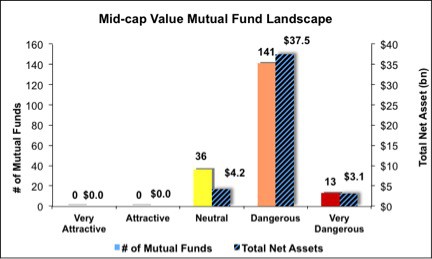The Mid Cap Value style ranks ninth out of the twelve fund styles as detailed in my Style Rankings for ETFs and Mutual Funds report. It gets my Dangerous rating, which is based on aggregation of ratings of 12 ETFs and 190 mutual funds in the Mid Cap Value style as of October 22, 2013. Prior reports on the best & worst ETFs and mutual funds in every sector and style are here.
Figure 1 ranks from best to worst the nine mid-cap value ETFs that meet our liquidity minimums and Figure 2 shows the five best and worst-rated mid-cap value mutual funds. Not all Mid Cap Value style ETFs and mutual funds are created the same. The number of holdings varies widely (from 25 to 2,846). This variation creates drastically different investment implications and, therefore, ratings. The best ETFs and mutual funds allocate more value to Attractive-or-better-rated stocks than the worst, which allocate too much value to Neutral-or-worse-rated stocks.
To identify the best and avoid the worst ETFs and mutual funds within the Mid Cap Value style, investors need a predictive rating based on (1) stocks ratings of the holdings and (2) the all-in expenses of each ETF and mutual fund. Investors need not rely on backward-looking ratings. My fund rating methodology is detailed here.
Investors should not buy any Mid Cap Value ETFs or mutual funds because none get an Attractive-or-better rating. If you must have exposure to this style, you should buy a basket of Attractive-or-better rated stocks and avoid paying undeserved fund fees. Active management has a long history of not paying off.
Get my ratings on all ETFs and mutual funds in this style by searching for Mid Cap Value on my freemutual fund and ETF screener.
Figure 1: ETFs with the Best & Worst Ratings – Top 5
Sources: New Constructs, LLC and company filings
Three ETFs are excluded from Figure 1 because their total net assets (TNA) are below $100 million and do not meet our liquidity minimums.
Figure 2: Mutual Funds with the Best & Worst Ratings – Top 5
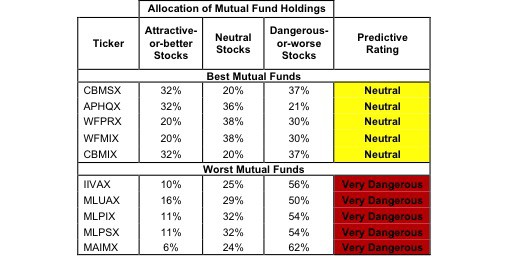 * Best mutual funds exclude funds with TNAs less than $100 million for inadequate liquidity.
* Best mutual funds exclude funds with TNAs less than $100 million for inadequate liquidity.
Sources: New Constructs, LLC and company filings
Six funds are excluded from Figure 2 because their total net assets (TNA) are below $100 million and do not meet our liquidity minimums.
WisdomTree MidCap Earnings Fund (EZM) is my top-rated Mid Cap Value ETF and Wells Fargo Advantage C&B Mid Cap Value Fund (CBMSX) is my top-rated Mid Cap Value mutual fund. Both earn my Neutral rating.
Guggenheim S&P 400 Midcap 400 Pure Value (RFV) is my worst-rated Mid Cap Value ETF and Munder Integrity Mid-Cap Value Fund (MAIMX) is my worst-rated Mid Cap Value mutual fund. RFV earns my Dangerous rating and MAIMX earns my Very Dangerous rating.
Figure 3 shows that 272 out of the 2,161 stocks (over 16% of the market value) in Mid Cap Value ETFs and mutual funds get an Attractive-or-better rating. However, no ETFs or mutual funds in the Mid Cap Value style allocate enough assets to Attractive-or-better rated stocks to earn an Attractive rating.
The takeaways are: mutual fund managers allocate too much capital to low-quality stocks and Mid Cap Value ETFs hold poor quality stocks.
Figure 3: Mid Cap Value Style Landscape For ETFs, Mutual Funds & Stocks
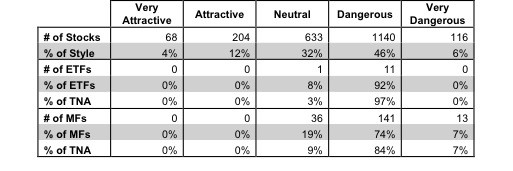 Sources: New Constructs, LLC and company filings
Sources: New Constructs, LLC and company filings
As detailed in “Low-Cost Funds Dupe Investors”, the fund industry offers many cheap funds but very few funds with high-quality stocks, or with what I call good portfolio management.
Investors need to tread carefully when considering Mid Cap Value ETFs and mutual funds. 11 out of 12 ETFs (97% of assets) and 154 out of 190 mutual funds (91% of assets) in the Mid Cap Value style earn a Dangerous-or-worse rating. Investors should steer clear of these dangerous funds and look for individual stocks instead.
US Airways Group (LCC) is one of my favorite stocks held by Mid Cap Value ETFs and mutual funds and earns my Very Attractive rating. LCC has grown operating profit (NOPAT) by 14% compounded annually over the past seven years. LCC also has an impressive return on invested capital (ROIC) of 13%, well above the industry average of 9%. LCC is a true value stock, and its low valuation makes it a safe bet for investors. At ~$22/share, LCC has a price to economic book value ratio of only 0.6, which implies a permanent 40% decline in NOPAT. Even if its proposed merger with American Airlines is successfully blocked, LCC should easily exceed the markets low expectations.
Cabela’s (CAB) is one of my least favorite stocks held by Mid Cap Value ETFs and mutual funds and earns my Very Dangerous rating. CAB also makes our Most Dangerous Stocks list for October. CAB hadmisleading earnings last year. CAB’s reported earnings grew by 20%, but its ROIC actually declined from 9% to 7%. To justify its current valuation of ~$63/share, CAB would need to grow NOPAT by 19% compounded annually for ten years. It’s hard to see a specialty retailer like CAB achieving that amount of growth.
Figures 4 and 5 show the rating landscape of all Mid Cap Value ETFs and mutual funds.
My Style Rankings for ETFs and Mutual Funds report ranks all styles and highlights those that offer the best investments.
Sources: New Constructs, LLC and company filings
Sources: New Constructs, LLC and company filings
Review my full list of ratings and rankings along with reports on all 12 ETFs and 190 mutual funds in the Mid Cap Value style.
Sam McBride contributed to this report.
Disclosure: David Trainer and Sam McBride receive no compensation to write about any specific stock, sector, style or theme.

